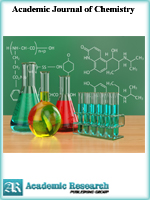Academic Journal of Chemistry
Online ISSN: 2519-7045
Print ISSN: 2521-0211
Print ISSN: 2521-0211
Quarterly Published (4 Issues Per Year)

Archives
Volume 2 Number 6 June 2017
Effect of Mn(II), Co(II), Ni(II), Cu(II), Zn(II) and Fe(III) Mixed Ligand Complexes on some Bacteria Causing Eyes Infections ( BCEI )
Authors: R. S. El-zweay ; M. M. El-ajaily ; O. A. Salem ; A. A. Maihub
Pages: 56-60
Abstract
The Mn(II), Co(II), Ni(II), Cu(II), Zn(II) and Fe(III) mixed ligand complexes were prepared by using 1,2-dihydroxybenzene (Catechol) as main ligand (HL1) and 2-hydroxybenzaldehyde (Salicyladehyde) as secondary-ligand (HL2). All the prepared mixed ligand complexes were characterized by using several physiochemical tools. Both electronic spectra and magnetic moment measurements exhibited the existence of an octahedral structure for Mn(II), Co(II) and Fe(III) complexes, square planar geometry for Ni(II) and Cu(II) complexes and tetrahedral structure for Zn(II) complex. The effect of the free ligands, metal salts and their mixed ligand complexes were examined on some bacteria species causing eyes infections (BCEI) such as Escherichia coli, Klebsiella pneumouiae and Staphylococcus aureus. Catechol has more effect than salicyldehyde on all tested bacteria, this is due to the existence of phenolic groups which are electron-releasing so increased the activity, meanwhile, the ligand and their mixed ligand complexes exhibited varying degrees of inhibitory effects on the growth of the bacteria strains.
In Vitro Elucidation Free Radical Scavenging Activity of Flavonoids Extracted From Leaves and Flowers of Arbutus Pavarii (Ericaceae)
Authors: Rabia Alghazeer ; Hussein El-Saltani ; Sana Elghmasi ; Nuri Awayn ; Khadiga Ben Mussa ; Fahima Massoudi
Pages: 42-55
Abstract
Increasing attention has been paid to the use of natural antioxidants, particularly of plant origin in order to substitute synthetic antioxidant due to their negative health effects. The aim of this study was to screen the flavonoid extracted from leaves and flowers of A. pavarii and their mixture of to show any antioxidant activity in vitro. the antioxidant and free radical scavenging activity were determined by several standard methods using spectrophotomer. Flavonoid extracts showed higher reducing ability in comparison with ascorbic and BHA. It was found that flavonoids extracted from leaves have the most activity to reduce the DPPH with an IC50 of 0.625mg/mL; more effective than others. This extract also exhibited fairly good antioxidant activity by inhibiting the generation of OH (IC50= 0.625mg/mL) and NO radicals (IC50= 1.25mg/ml). The inhibition of lipid peroxidation was recorded in flavonoids extracted from leaves (60%). Synergism was the main effect among the combined extract, C3 (L:F; 2: 1). Three types of interactions (synergistic, additive and negative synergistic effect) were observed.



